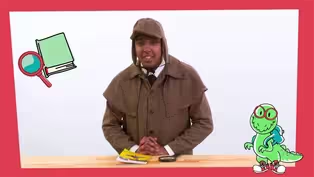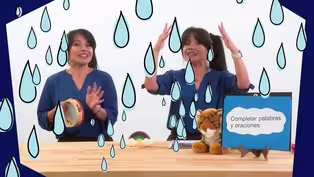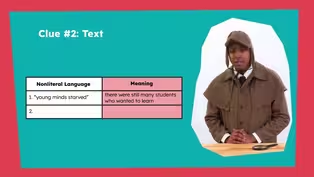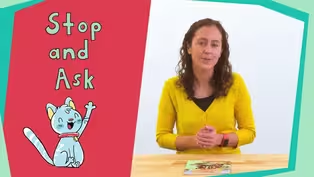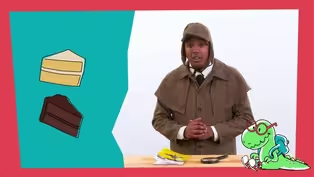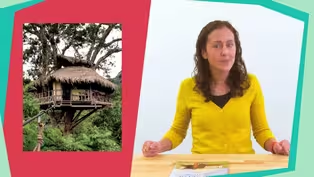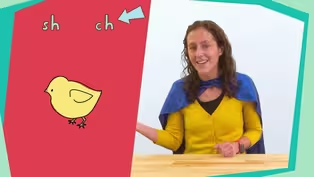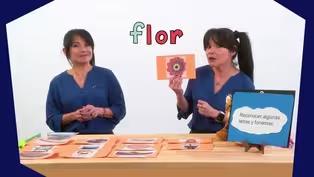
Episode 28 | Literacy Lessons
4/13/2021 | 28m 46sVideo has Closed Captions
Literacy lessons for early learners, led by NC teachers.
The first lesson (aimed at 3rd graders) helps students understand the basic structure and characteristics of a poem. The second lesson (aimed at PreK-K learners) focuses on concepts of print and vocabulary development. Classroom Connection is your At-Home Learning companion where children love to learn. All lessons are led by NC educators.
Problems playing video? | Closed Captioning Feedback
Problems playing video? | Closed Captioning Feedback
At-Home Learning Presents: Classroom Connection is a local public television program presented by PBS NC

Episode 28 | Literacy Lessons
4/13/2021 | 28m 46sVideo has Closed Captions
The first lesson (aimed at 3rd graders) helps students understand the basic structure and characteristics of a poem. The second lesson (aimed at PreK-K learners) focuses on concepts of print and vocabulary development. Classroom Connection is your At-Home Learning companion where children love to learn. All lessons are led by NC educators.
Problems playing video? | Closed Captioning Feedback
How to Watch At-Home Learning Presents: Classroom Connection
At-Home Learning Presents: Classroom Connection is available to stream on pbs.org and the free PBS App, available on iPhone, Apple TV, Android TV, Android smartphones, Amazon Fire TV, Amazon Fire Tablet, Roku, Samsung Smart TV, and Vizio.
Providing Support for PBS.org
Learn Moreabout PBS online sponsorshipMore from This Collection
Video has Closed Captions
Literacy lessons for early learners, led by NC teachers. (28m 46s)
Video has Closed Captions
Literacy lessons for early learners, led by NC teachers. (28m 46s)
Video has Closed Captions
Literacy lessons for early learners, led by NC teachers. (28m 45s)
Video has Closed Captions
Literacy lessons for early learners, led by NC teachers. (28m 45s)
Video has Closed Captions
Literacy lessons for early learners, led by NC teachers. (28m 46s)
Video has Closed Captions
Literacy lessons for early learners, led by NC teachers. (28m 46s)
Video has Closed Captions
Literacy lessons for early learners, led by NC teachers. (28m 45s)
Video has Closed Captions
Short Description: Literacy lessons for early learners, led by NC teachers. (28m 45s)
Video has Closed Captions
Literacy lessons for early learners, led by NC teachers. (28m 45s)
Video has Closed Captions
Literacy lessons for early learners, led by NC teachers. (28m 45s)
Video has Closed Captions
Literacy lessons for early learners, led by NC teachers. (28m 45s)
Video has Closed Captions
Literacy lessons for early learners, led by NC teachers. (28m 45s)
Providing Support for PBS.org
Learn Moreabout PBS online sponsorship[cheerful upbeat music] ♪ - All right, get ready for a super cool literacy lesson.
Literacy means reading, and we're gonna learn all about reading sounds, words, and sentences.
Did you know without reading you wouldn't know what street you live on?
How would you even get the mail?
We'll get ready because we're going to get started right now.
- Hi again, everyone.
I'm Ms. Shannon and sun and I are back, but this time with a brand new text.
Today, we're going to read a poem.
We're so excited.
You may have seen or heard poems before they often rhyme, but not always.
And they're organized in a very special way.
Let me show you.
The poem we're reading today is from the book.
The day the universe exploded my head by Alan Wolf.
The book has tons of poems, all about outer space but we only have time for one today.
If you like it, you should check the book out from the library to explore the rest of the poetry in it.
[air whooshing] Since we've been reading all about the sun lately we're going to continue that learning and read the first poem in the book which is called "The Sun, A Solar Sunnet, er, Sonnet."
This subtitle is funny because the author Alan Wolf is playing with words here.
A Sonnet is a special type of poem.
I'll show you more about that in just a minute, but for now do you see how Alan Wolf played with the words?
Because the Sonnet is about the sun, he changed the O to a U to make sunnet Sonnet.
Just from that start we can already tell this is going to be a fun poem to read.
Let's start by talking about the parts of a poem.
Poems are very different from other types of texts.
Poetry can have lines stanzas and a rhyme scheme.
We'll explore each of these today with our poem about the sun.
The first part of poetry that I wanna show you is a lines.
You'll notice that poets are people who write poems write lines that can stop anywhere in a row of text.
This is different from sentences and other types of texts that go all the way to the end of each row on the page.
See the difference?
When a line is finished the poet goes down to the next row to start a new line.
Even if they're space left to right in the row.
This is different from sentences we see in other types of texts.
When we're writing a paragraph, if a sentence ends and there's still room to write more on a line, you just start the sentence on the same row.
But in poetry lines are important because they affect the speed and rhythm of the poem or how it sounds when it's read aloud.
If we count the lines in this poem that we'll be reading today we see there are 14.
Count with me one, two, three, four, five, six, seven eight, nine, 10, 11, 12, 13, 14 because this is a special type of poem called a Sonnet.
You'll notice that each line has 10 syllables.
We don't have time right now to count the syllables in every line.
So let's just do one.
You can count the rest later on your own if you'd like.
Watch me read the first line and you can help me count the syllable.
Born four [soft upbeat music] and one half billion years ago, see 10.
The other thing I want you to know about poetry is that the lines are organized in groups called stanzas.
If we look at this poem we can see the groups of lines together that formed this stanzas.
See there's space between each one.
Here's the first stanza and the second.
Keep counting how many are there all together?
Yes, there are one, two, three, four stanzas.
Great job, it's kind of interesting to notice here that all of the stanzas have four lines, except for the last one.
It only has two.
That's another characteristic of this particular type of poem, a Sonnet.
Another thing to think about with poetry is the rhyme schemes.
Not all poems rhyme but many do.
The ones that do have rhyming words can be studied closely to figure out their rhyme scheme.
A poem's rhyme scheme, lets us know which words rhyme.
We use letters to label it.
Watch me do the first stanza and then you can help me.
To do this we only need to look at the last word in each line.
The last word in the first line is ago and I'll label it with the letter a.
The last word of the second line is mass.
Mass doesn't rhyme with ago so I can't label that one with a it needs a different letter.
We just go in abc order.
So I'll label this b.
The last word the third line is nose.
No rhymes with ago which was what we labeled a, since they rhyme this one is labeled a also.
So you see that you use the same letters for rhyming words and new letters for ones that don't have rhyme yet.
So we figured out the rhyme scheme for the first three lines in this stanza is a b a.
Let's do the last one, the last word in line for his grasp.
It nearly rhymes with mass, which we labeled b in line two.
When we say those words, aloud, mass and grasp they are what is called a slant rhyme.
Meaning they sound similar and close enough to label with the same letter in our poetry rhyme scheme.
So I'll label that one as b also.
Now you do the second stanza the end of the first line is start.
That's doesn't a rhyme with any words we found at the end of each line in the first stanza.
So we need a new letter, which letters should we use?
Yes, c. The next line says, atmosphere how should we label it?
Yes d because we haven't found any other words that rhyme with it yet.
The end of the next line says heart how should we label that?
Great thinking we should label it c because it rhymes with start which was at the end of the first line in the stanza.
The stands up the last line in this stanza ends with here.
How should we label that?
Here rhymes with atmosphere from line two in this stanza.
So we'll label it d. If you kept going like this through the rest of the poem you could label the rhyme scheme of the entire thing.
So now we know about important parts of poetry.
Poetry can have lines, stanzas and rhyme scheme.
We learned that our poem has 14 lines, four stanzas and we labeled the rhyme scheme in the first two stanzas.
Before we read our poem, remember that it's a special type called a Sonnet.
As a Sonnet this poem has four stanzas.
The first three stanzas have four lines and the last one has two.
All together it has 14 lines and each line has 10 syllables.
When we look at our rhyme scheme so far it looks like every other line rhymes.
Pay attention as we read the rest of the poem to see if that rhyme scheme carry throughout the whole text.
Now that we know how the poem is organized it will make more sense as we read.
I'll read it this time while you listen and think about what it means then we'll summarize each stanza.
Summarizing after you read chunks of text is a great way to check your understanding.
All right, let's get started with stanza one.
Remember that you are listening and thinking about what the poem is saying.
Born four and one half billion years ago.
I'm 99.8% the mass of everything the solar system knows.
My gravity holds all within its grasp.
So the gist of that stanza is that the sun is really old, large and holds the solar system together.
That makes sense, because we found all of those facts in the last book we read together.
Which was called sun one in a billion so I know this is accurate.
Wow, summarizing the stanza helped me to understand what the poem was saying and also make connections to another text we've read.
Let's read it again, this time, all together.
Born four and one half billion years ago, I'm 99.8% the mass of everything the solar system knows.
My gravity holds all within its grasp.
Let's keep reading.
Listen to me, read stands a two and think about what it means.
And then I'll summarize my understanding.
I watched as each young planets got it starts.
I sheltered them inside my atmosphere.
I am the solar system's burning heart the light and the life of everything that's here.
So the gist of this stanza is similar to the first stanza.
The sun is old and the center of our solar system but it's important to notice how stanza two builds on stanza one.
What new information do we learn in the second stanza?
Yes it goes a little deeper than the first stanza and says that the sun is so old that it saw each planet get its start.
And without the sun, other planets couldn't exist.
This time when I summarized my understanding of stanza two I asked myself questions that helped me make connections to other parts of this text.
Let's read stanza two again this time all together.
I watched as each young planet got its start.
I sheltered them inside my atmosphere.
I am the solar system's burning heart, the light and life of everything that's here.
Let's go on to stanzas three and four.
As I read, I want you to think about how they build on the first two stanzas that we already read.
What new information do they give us?
I lit the fires that made you what you are.
When times were dark, I rose above it all.
Next time you want to wish upon a star you need not even wait for night to fall.
The simple truth may come as a surprise, the closest star right before your eyes.
So what new information did you hear?
What I heard is in the second stanza the sun said that the planets couldn't exist without it.
And it takes this even deeper in the third stanza and says we wouldn't be alive without it.
See, it says, "I let the fires that made you what you are."
Alan Wolf wants to make sure that we know the sun is actually a star.
The last stanza is really interesting because it's pretty neat that the thing that keeps the solar system together and us alive is actually a star.
We don't usually think about stars in this way.
We usually think about wishing on stars or shooting stars, not the sun.
So each stands a builds on the ones before it to help us come to this neat realization that the sun is actually a star.
Now that we understand all of its parts let's read the whole poem together.
Notice the lines, stanzas, rhyming words and how the information in each stanza builds on the one before.
Read with me, the sun, a solar Sunnet, er, Sonnet.
Born four in one half billion years ago, I'm 99.8% the mass of everything the solar system knows.
My gravity holds all within its grasp.
I watched as each young planet, got it start.
I sheltered them inside my atmosphere.
I am the solar system's burning heart the light into life of everything that's here.
I lit the fires that made you what you are.
When times were dark I rose above it all.
Next time you want to wish upon a star.
you need not even wait for night to fall.
The simple truth may come as a surprise: the closest star is right before your eyes.
Excellent reading.
It's great to read poems more than once to really get into their rhythm and deeply explore their meanings.
Today we learned that poems have unique parts called lines, stanzas s and rhyme schemes.
We read a special type called a Sonnet.
There are different types of Sonnets but the one we study today had 14 lines with 10 syllables each four stanzas and a definite rhyme scheme.
We also learned that in poetry the stanzas build on each other so that you can clearly understand the ideas the poet wants you to remember.
When you're reading poetry see if you can count the number of lines stanzas and label the rhyme scheme.
You can even use what we've learned about these poetry parts to write your own poems.
We'll see you next time.
When we explore a brand new poem about the sun, see you soon.
- It was really fun to practice our reading and writing today.
What was your favorite part?
Think about that while we get ready for the next fun activity.
- Hi everyone I'm Ms. Raven.
We are going to be stretching today.
If you would just open your legs up about hip width a part we're gonna stretch our legs so that we are nice and limber for our movement.
We're gonna start with reaching over to the left and try to reach the wall all the way to the side of you reach as far as you can.
And we're gonna open back [upbeat music] and we'll shift to the right.
Again you're gonna want to reach as far as you can to the right as possible, good job.
This time, we're going to take our hands and bent to our left and touch our left set of toes.
Get a good stretch in your legs and we'll come back to center and reach to our right center toes.
You should feel a nice pull on those legs.
All right, that's a center.
We're gonna reach up really high and touch both sets of toes.
Good job, and here we'll meet with the plea.
So you'll just bend at the knees and come up and bend at the knees and back up.
And we'll bend one more time, but we'll hold.
This time we're going to push our right knee back.
Good job, and we'll switch and push our left knee back.
Awesome, thank you for stretching with me and I'll see you next time.
[gentle upbeat music] - Hello, super learners.
My name is Ms. Jennifer, and I'm so excited that you were here to learn with me today.
You will need a stuffed animal for today's lesson.
Ask a trusted adult to help you find it.
While you're getting your supplies I'm gonna grab mine as well.
I'll be right back.
[soft upbeat music] Okay, I'm back now and I see you are too.
We have our stuffed animal so now let's get started.
Today we're gonna be reviewing the parts of a book making sure to read from left to right and sorting animals into categories.
We will also read a story about baby animals and make a connection to another story we read.
Are you ready?
All right, super learners let's get started.
Here is our book for today.
It is called, "Is It A Baby Animal?"
The author of this story is Bridget Taylor.
She wrote the words we will be reading.
This book does not have an illustrator because there are no drawn pictures.
The pictures in this story are photographs of real animals.
This part of the book is called the front cover.
It has the title, "Is It A Baby Animal?"
The author's name, Bridget Taylor and a picture showing what the story is about.
This is the back cover.
Remember that the front and the back cover worked together to protect the pages.
This is the spine it holds the pages together.
Now let's go back to the front cover.
Take a look at the picture.
In the picture we can see some animals.
Let's name these animals.
We have a bear, a kitten, a puppy and duckling.
I wonder if we will see any other animals in our story.
What other animals do you hope to learn?
Oh, a wolf, alligator fish there are so many options.
Let's find out when we open our book the first page we come to is the title page.
Do remember why it is called the title page?
That's right it has the title on it.
We can see it right here "Is It a Baby Animal?"
Now let's read our book and find out if the animals we see are baby animals or adult animals.
Adult is another way to say grown-up.
Now I'm going to start reading on the left and go to the right.
Is a kitchen, a baby animal?
A kitten is a baby cat.
Is a puppy, a baby animal?
Tell your stuff, friend.
Yes, it is.
A puppy is a baby dog.
Is a Cub a baby animal?
Tell your stuff a friend.
Yes, it is a cup is a baby bear.
Is a duckling, a baby animal?
Tell you stuff, a friend.
Yes, it is.
A duckling is a baby duck.
Wow, we've learned a lot of animal names.
Some of the animals were adult animals and some were baby animals.
We can tell that an animal is a baby because it is smaller than the adult.
We have some of animals.
Some of them are adult animals and some are baby animals.
I need to sort them by deciding if they are adult animals or babies.
I'm going to write on the board I'm going to write the word adult on this side.
Then I'm going to write on baby on this side.
I'll need your help so that I put the animals in the right places.
So first we have a cat.
Tell me your stuff, friend.
If a cat is an adult or baby animal?
Did you say a cat as an adult?
That's right.
In our story we learned that a cat is an adult animal.
I'm going to put it on the adult side.
Now can you stand up tall and me out like a cat.
Meow!
Meow!
Now we have a kitten.
Tell your stuff, a friend if a kitten is an adult or baby animal.
Did you say a kitten is a baby animal?
That's right.
We learned from our story that a kitten is a baby cat.
Can you crouch down low and Meow like a kitten.
Meow!
Meow!
Great job now we have a dog.
Tell your stuff, friend a dog is an adult or baby animal.
Did you say a dog is an adult?
That's right.
In our story, we learned that a dog is an adult animal.
Can you stand up tall and bark like a dog?
Woof!
Woof!
Now, we have a puppy.
Tell your stuff, friend if a puppy is an adult or baby animal.
Did you say a puppy is a baby animal?
That's right.
We learned from our story that a puppy is a baby dog.
Can you catch down low and bark like a puppy?
Now we have a bear.
Tell your stuff, friend if a bear is an adult or baby animal.
Did you say a bear as an adult animal?
That's right, in our story we learned that a bear is an adult animal.
Can you stand up tall and growl?
Rawr!
Rawr!
Now we have a Cub.
Tell your stuff, friend if a Cub is an adult or baby animal Did you say a Cub is a baby animal?
That's right, we learned from our story that a Cub is a baby bear.
Can you crouch down low and growl like a Cub?
Now you have a duck.
Tell your stuff a friend if a duck is an adult or baby animal.
Did you say a duck is an adult?
That's right, and our story, we learned that a duck is an adult animal.
Can you stand up tall and quack, like a duck?
[quacking] Now we have a duckling.
Tell your stuff, friend if a duckling is an adult or a baby animal.
Did you say a duckling is a baby animal?
That's right, we learned from our story that a duckling is a baby duck.
Can you crouch down low and quack like a duckling?
Now we have eight a pig.
Tell your stuff, tell your stuff, friend If a pig is an adult or baby animal.
Did you say a pig is an adult?
That's right, we saw this animal in our story "Little Piglet" Can you stand up tall and oink like a pig.
Oink!
Oink!
Now we've read another book about mother pig.
Do you remember that story?
Now we have a piglet.
Tell your stuff, friend if, if a piglet is an adult or baby animal.
Did you say a piglet is a baby animal?
That's right, we learned from our story that a piglet is a baby pig.
Can you crouch down low and oink like a baby pig?
In our story, "Little Piglets" those silly piglets for hiding from their mother pig.
Do you remember where she found them?
Tell your stuff, friend.
That's right they were hiding beside the pod.
Now, we have a sheep.
Where should we put it on the adult side or the baby side?
That's right, we should put it on the adult side.
Now we have a lamb.
Tell your stuff, friend if a lamb is an adult or baby animal.
Did you say a lamb is a baby?
That's right, we saw this animal in our story "Little Pigs."
Can you crouch down low and baow like a lamb.
Now we have a hen.
Where should we put it on the adult side or the baby side?
That's right, we should put it on the adult side.
A hen is a female or girl chicken.
For our last animal, we have a chick.
Telling your stuff, friend if I chick is an adult or baby animal.
Did you say a check as a baby animal?
That's right, we saw this animal in our story Little piglets.
Can you crouch down low and peep like a chick.
Peep!
peep!
You did an excellent job making animal sounds.
You did such a good job shot telling me who the adult and baby animals were.
Super learners we are at the end of our lesson for today.
Thank you so much for being with me as we reviewed the parts of a book, made sure to read from left to right and sorted animals into categories.
I'll see you next time.
- Well, that's all the time we have for today.
I can't wait to see you next time.
In the meantime, be kind each other.
Wishing you peace, love and learning.
[cheerful upbeat music] ♪
Support for PBS provided by:
At-Home Learning Presents: Classroom Connection is a local public television program presented by PBS NC
